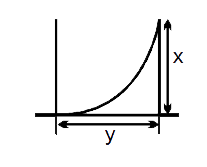Show that the frequency of revolution, of a charged particle (in the X-Y plane), in a uniform magnetic field →B(=Bˆk) is independent of its speed.
Which pratical machine makes use of this fact?
What is the frequency of the alternating electric field used in this machine?
The radius of the cirucular path traced by charged particle in a perpendicular uniform magnetic field is r=mvqB
Frequency of revolution,
vc=1T=v2πr=v×qB2π×mv=qB2πm
which is independent of speed v.
A cyclotron makes use of this fact in which alternating electric field of frequency vc is applied.
Topper's Solved these Questions
- BOOK - PRADEEPCHAPTER - MAGNETIC EFFECT OF CURRENT AND MAGNETISMEXERCISE - Conceptual Problems (d)2videos
MAGNETIC EFFECT OF CURRENT AND MAGNETISM
- BOOK - PRADEEPCHAPTER - MAGNETIC EFFECT OF CURRENT AND MAGNETISMEXERCISE - Very Short Answer Questions (a)2videos
MAGNETIC EFFECT OF CURRENT AND MAGNETISM
- BOOK - PRADEEPCHAPTER - ELECTROSTATICSEXERCISE - ASSERTION-REASON TYPE QUESTIONS2videos
ELECTROSTATICS
- BOOK - PRADEEPCHAPTER - OPTICSEXERCISE - Multiple choice questions1videos
OPTICS
Similar Questions
Deduce an expression for the frequency of revolution of a charged particle in a magnetic field and show that it is independent of velocity or energy of the particle.
View SolutionDeduce the expression for the frequency of revolution of a charged particle in a magnetic field and show that this is independent of the velocity or energy of the particle.
View Solution
Knowledge Check
- Question 1 - Select One
he time period of a charged particle undergoing a circular motion in a uniform magnetic field is independent of its
AmassBchargeCspeedDmagnetic induction - Question 2 - Select One
The time period of a charged particle undergoing a circular motion in a uniform magnetic field is independent of its
AspeedBmassCchargeDmagnetic induction - Question 3 - Select One
The time-period of a charged particle undergoing a circular motion in a uniform magnetic field in independent of its
AspeedBchargeCmassDmagnetic induction
What is the direction of the force acting on a charged. Particle q moving with a velocity →v in a uniform magnetic field →B ?
View SolutionIn the previous problem what will be the frequency of electric field if the charge particle is α-particle?
View SolutionA charged particle moves in a circular path in a uniform magnetic field. If its speed is reduced, then its time period will
View SolutionA particle having charge q enters a region of uniform magnetic field →B (directed inwards) and is deflected a distance x after travelling a distance y. The magnitude of the momentum of the particle is
 View Solution
View SolutionA charged particle of charge q and mass m is shot into a uniform magnetic field of induction B at an angle θ with the field. The frequency of revolution of the particle
View Solution

